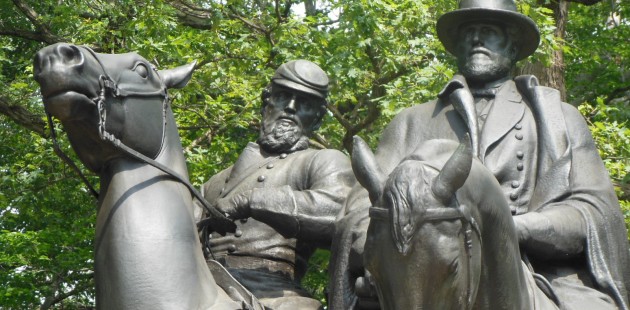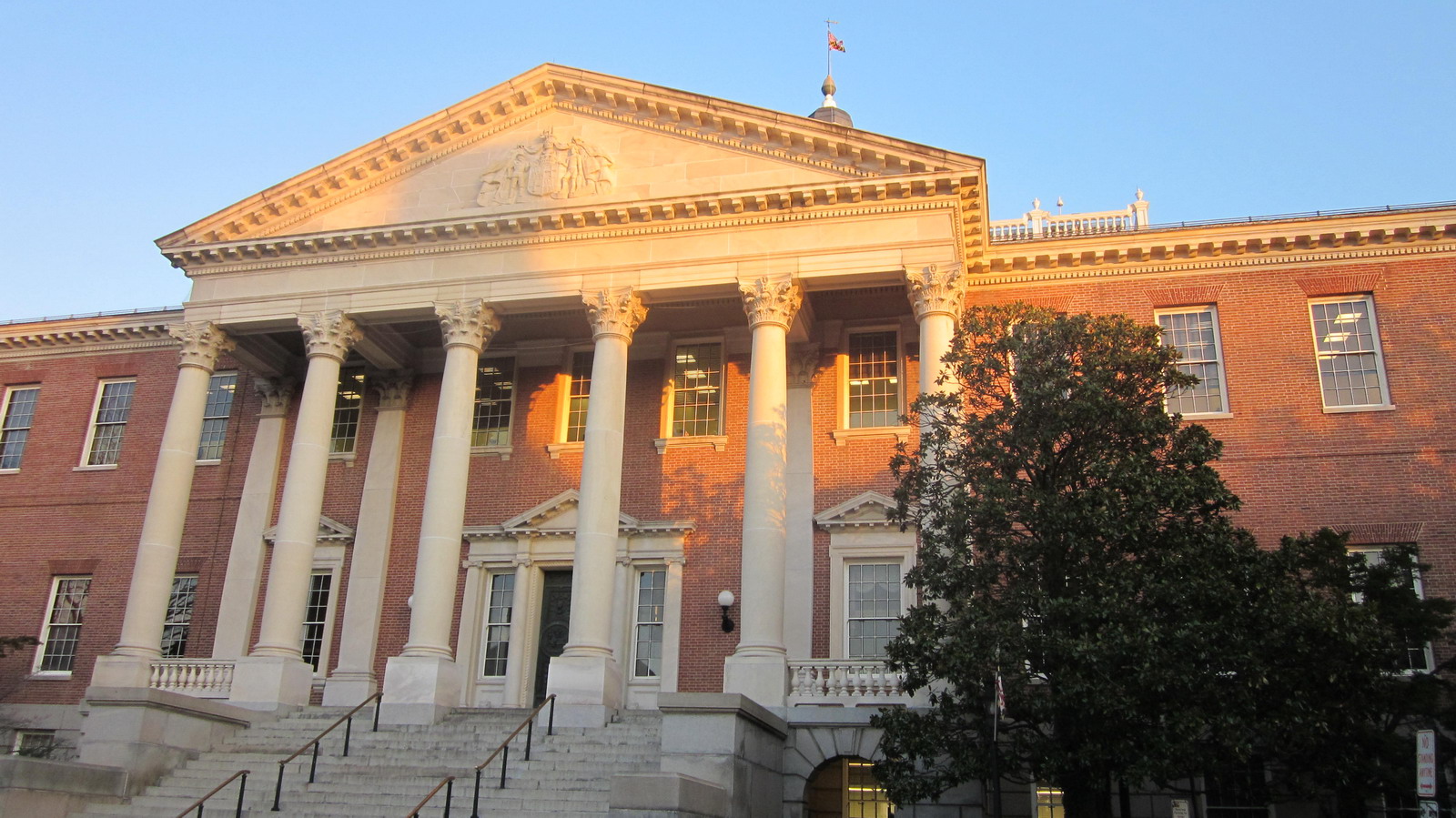By Barry Rascovar
For MarylandReporter.com
In this seminal period of American history, it is important for elected officials to display moral courage and leadership rather than more fashionable politics of survival – and a craven pandering to people’s baser instincts.
Both Maryland Gov. Larry Hogan and Baltimore Mayor Catherine Pugh took the high road last week, doing what was right even if it proved controversial.
The two leaders acted quickly to remove Civil War-era statues that inflamed public debate, thanks to President Trump’s incendiary comments following a neo-Nazi, white supremacist rally and a later domestic terrorist attack in Charlottesville, Va.
The two Marylanders are getting flak for their prompt, common-sense decisions. They even drew criticism for daring to provide sensible arguments for their actions.
While this dispute superficially involves the removal of statues honoring the Confederacy and slavery, the culture war erupting nationwide is forcing Americans to confront some of this country’s darkest history.
Ever since the end of the North-South confrontation that lasted four bloody years, there’s been a concerted effort to patch things over and get on with “reconciliation.” Southern leaders, meanwhile, have tried to keep the image of the ante-bellum era alive, turning Confederate leaders into hallowed heroes and their traditions into a virtue.
Those divergent initiatives led to Confederate statues arising around the country. Four in Baltimore now have been removed as has one on the State House grounds in Annapolis.
Lee-Jackson on horseback
The Lee-Jackson equestrian statue in Wyman Park dell near the Baltimore Museum of Art should have come down long ago. It was an embarrassment, an ode to two military men who betrayed their country and sought to tear it asunder.
Their actions do not merit a salute on public city property. Neither Robert E. Lee nor Thomas “Stonewall” Jackson showed up in the vicinity of Baltimore during the Civil War. There’s no reason for this statue to be in a Baltimore park.
Pugh hit a home run when she suggested the equestrian bronze rightly belongs on the Chancellorsville battlefield in Spotsylvania, Va. That is where Lee and Jackson concocted a brilliant strategy that pulled off a surprising victory – one that was marred by Jackson’s friendly-fire wounding and subsequent death.
As for the two statues of Roger B. Taney (1777-1864), the issue is more complex. Taney, the fifth chief justice of the U.S. Supreme Court, stands out as the most prominent Marylander to serve in high federal posts for an extended period of time.
After election to the Maryland House of Delegates, state Senate and then to the office of state attorney general, Taney took on the role of President Andrew Jackson’s attorney general and later secretary of the Treasury. He was the most influential member of Jackson’s “kitchen cabinet” and architect of Jackson’s campaign to abolish the Second Bank of the United States.
This was a pivotal issue in Jackson’s election and re-election. Taney provided a glide path for President Jackson, who was the Bernie Sanders of his time – a populist intent on bringing the voice of the common man into the White House.
Taney on the Supreme Court
Jackson then chose Taney to succeed the giant of Supreme Court chief justices, John Marshall. It was a position Taney held for over 28 years.
A state’s rights constitutionalist, Taney broke new ground in commercial law, the enforcement of legally binding contacts and the decision-making authority of popularly elected state legislatures.
One landmark written opinion, though, left Taney’s reputation in tatters. From the moment the Dred Scott decision was announced in 1857, it was excoriated for its harsh and inhuman characterization of African Americans.
Scott, Taney wrote, had no standing to file a lawsuit because African Americans – both freedmen and slaves – possessed “no rights which the white man was bound to respect.”
From today’s vantage point, there’s no doubt of the terrible wrongness of Taney’s declaration. But in the context of his times, Taney’s viewpoint was supported by many Americans, including six other Supreme Court justices who supported Taney’s majority opinion.
According to an amazingly timely account of the Taney statues in the spring/summer issue of the Maryland Historical Magazine, Taney’s bronze image came about as a result of diametrically opposed drives by state legislators: One group sought reconciliation after the war by honoring Maryland’s most famous national figure. The other group had clear white supremacist goals, using Taney’s Dred Scott opinion as the rationale for their racist views.
Bronzes are born
William Henry Rinehart, a renowned Maryland sculptor, cast the Taney bronze in his Rome workshop. It cost taxpayers $10,000 (about $250,000 in today’s dollars). The statue’s unveiling in 1872 was a major state event. A duplicate of Taney’s head, neck and shoulders, with alterations, was later commissioned for Baltimore, crafted by the brilliant American Beaux-Arts sculptor, Augustus Saint-Gaudens.
These are historically accurate and important works. Demagogic demands by gubernatorial candidate Ben Jealous and Baltimore City Councilman Brandon Scott to melt down those artistic creations are despicable attempts at modern-day book-burning. Such demands bring into question these individuals’ temperament as public figures.
Both Hogan and Pugh placed the controversial statues in storage until an appropriate home can be found. Flame-throwers on both the far-right and far-left would love to make these statues a cause celebre to further their opportunistic objectives.
No wonder the bronzes were moved overnight from their sites. Public safety was at risk.
Appropriate replacements
Now the question becomes: What should replace these discredited public monuments?
Why not commission statues of unifying figures from Maryland’s recent past, such as political giants:
- William Donald Schaefer (four-time Baltimore mayor and two-time governor),
- Theodore Roosevelt McKeldin (two times both governor and Baltimore mayor),
- Barbara Mikulski (feminist ground-breaker and longest-serving female member of the U.S. Senate), and
- Charles “Mac” Mathias (seminal centrist politician in both the U.S. House and Senate).
Or perhaps we should replace the Baltimore bust of Taney with a bust of the most recent Maryland Supreme Court justice, Baltimore-born Thurgood Marshall, the first African-American jurist on the nation’s highest court.
What about Nancy D’Alesandro Pelosi – the Baltimore daughter of a three-term mayor and five-term congressman, Thomas “Old Tommy” D’Alesandro, Jr. – who rose to the highest rung of the U.S. House of Representatives as the nation’s first female Speaker of the House?
Or maybe we should avoid political figures and honor in bronze the likes of James Rouse, the pioneering urban planner (the new town of Columbia, Harborplace, Cross Keys, Mondawmin and Harundale Mall – the first enclosed shopping center east of the Mississippi).
Why not a bronze statue commemorating philanthropists like Johns Hopkins, Enoch Pratt and George Peabody, whose selfless contributions to the Baltimore region have endured for over a century?
It’s time to move on from 150-year-old Civil War divisions.
Let us find proper, appropriate sites for controversial statuary art from that era.
Then let us honor and commemorate men and women of all races who have made metropolitan Baltimore and Maryland better because of their dedication and hard work for the common good.
Barry Rascovar’s blog is www.politicalmaryland.com. He can be reached at brascovar@hotmail.com.






I submit that the praise bestowed on Gov. Hogan for his role in the very desirable removal of the Taney statue from the state house grounds is way overdone (both by Mr. Rascovar and others). There is a four-member State House Trust that deals with such matters and the governor or his designee chairs it. The other three members of this panel are Senate president Mike Miller, House speaker Mike Busch, and a representative of the Maryland Historical Trust named Charles Edson. Speaker Busch was the one who initiated the request that the statue be removed and two other members of joined him in voting via e-mail to do so. Those other affirmative votes were reportedly cast by Mr. Edson and the governor’s designee (Lt. Gov. Boyd Rutherford). Mike Miller sent a long message that defended Taney and criticized the e-mail voting process. The governor played no role other than to pontificate. Two years ago he had called requests for removal of the Taney statue as “political correctness run amok.” This seems like another of those many instances where the governor has ignored either signing or vetoing bills and thus letting them go into effect without his signature.
While we’re at it… All of the statues, locations, memorials about the War of Independence and the War of 1812 should be shuttered, removed, etc. because there were slaves here… < sarcasm And let's remove all statues, etc. relating to blacks as well...< sarcasm I really didn't appreciate the secrecy of doing the deed of removing the statues... It was cowardly and I will remember come 2018... This is more like what the Communist do ! Before this past week and weekend, was there any outcry against the statues in Baltimore and Annapolis ? Also, if statues can intimidate you... You need serious mental and emotional help ! And a statue of a pregnant black woman with a raised fist was put in place of one of the statues... I believe it was called "Mother Light"... If that is what you aspire to Baltimore... Also, crime in the City continues apace... I read at a crime reporting site that there were 158 crimes reported on ( 08/17 ), the day the statues were removed... And there have been 226 homicides this year and there are 4 months to go... But, the statues... And we know about what happens to those who don't remember, never learn, or who rewrite history...
I am quick to criticize Mr. Rascovar when I disagree with his writings but today’s post was a well written and thought out piece.